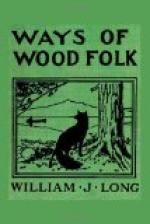He carried the prize home, trap and all, over his shoulder. At his whoop of exultation the whole family came out to admire and congratulate. At last he took the trap from the fox’s leg, and stretched him out on the doorstep to gloat over the treasure and stroke the glossy fur to his heart’s content. His attention was taken away for a moment; then he had a dazed vision of a flying black animal that seemed to perch an instant on the log fence and vanish among the spruces.
Poor Johnnie! There were tears in his eyes when he told me about it, three years afterwards.
* * * * *
These are but the beginning of fox-ways. I have not spoken of his occasional tree climbing; nor of his grasshopper hunting; nor of his planning to catch three quails at once when he finds a whole covey gathered into a dinner-plate circle, tails in, heads out, asleep on the ground; nor of some perfectly astonishing things he does when hard pressed by dogs. But these are enough to begin the study and still leave plenty of things to find out for one’s self. Reynard is rarely seen, even in places where he abounds; we know almost nothing of his private life; and there are undoubtedly many of his most interesting ways yet to be discovered. He has somehow acquired a bad name, especially among farmers; but, on the whole, there is scarcely a wild thing in the woods that better repays one for the long hours spent in catching a glimpse of him.
II. MERGANSER.
[Illustration]
Shelldrake, or shellbird, is the name by which this duck is generally known, though how he came to be called so would be hard to tell. Probably the name was given by gunners, who see him only in winter when hunger drives him to eat mussels—but even then he likes mud-snails much better.
The name fish-duck, which one hears occasionally, is much more appropriate. The long slender bill, with its serrated edges fitting into each other like the teeth of a bear trap, just calculated to seize and hold a slimy wriggling fish, is quite enough evidence as to the nature of the bird’s food, even if one had not seen him fishing on the lakes and rivers which are his summer home.
That same bill, by the way, is sometimes a source of danger. Once, on the coast, I saw a shelldrake tying in vain to fly against the wind, which flung rudely among some tall reeds near me. The next moment Don, my old dog, had him. In a hungry moment he had driven his bill through both shells of a scallop, which slipped or worked its way up to his nostrils, muzzling the bird perfectly with a hard shell ring. The poor fellow by desperate trying could open his mouth barely wide enough to drink or to swallow the tiniest morsel. He must have been in this condition a long time, for the bill was half worn through, and he was so light that the wind blew him about like a great feather when he attempted to fly.




